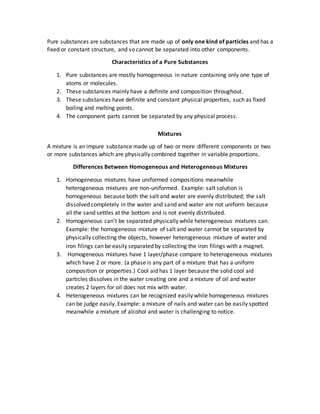
Pure substances
- 1. Pure substances are substances that are made up of only one kind of particles and has a fixed or constant structure, and so cannot be separated into other components. Characteristics of a Pure Substances 1. Pure substances are mostly homogeneous in nature containing only one type of atoms or molecules. 2. These substances mainly have a definite and composition throughout. 3. These substances have definite and constant physical properties, such as fixed boiling and melting points. 4. The component parts cannot be separated by any physical process. Mixtures A mixture is an impure substance made up of two or more different components or two or more substances which are physically combined together in variable proportions. Differences Between Homogeneous and Heterogeneous Mixtures 1. Homogeneous mixtures have uniformed compositions meanwhile heterogeneous mixtures are non-uniformed. Example: salt solution is homogeneous because both the salt and water are evenly distributed; the salt dissolved completely in the water and sand and water are not uniform because all the sand settles at the bottom and is not evenly distributed. 2. Homogeneous can’t be separated physically while heterogeneous mixtures can. Example: the homogeneous mixture of salt and water cannot be separated by physically collecting the objects, however heterogeneous mixture of water and iron filings can be easily separated by collecting the iron filings with a magnet. 3. Homogeneous mixtures have 1 layer/phase compare to heterogeneous mixtures which have 2 or more. (a phase is any part of a mixture that has a uniform composition or properties.) Cool aid has 1 layer because the solid cool aid particles dissolves in the water creating one and a mixture of oil and water creates 2 layers for oil does not mix with water. 4. Heterogeneous mixtures can be recognized easily while homogeneous mixtures can be judge easily. Example: a mixture of nails and water can be easily spotted meanwhile a mixture of alcohol and water is challenging to notice.
- 2. Difference Between an Aqueous and Non-aqueous solution An aqueous solution has water as the solvent that dissolves the solute. E.g., salt in water, sugar in water and copper sulphate in water and a non-aqueous solution is when the solute dissolves in the solvent other than water. E.g., iodine in carbon tetrachloride, Sulphur in carbon disulfide and phosphorous in ethyl alcohol. Types of Solution SOLUTION Solute Solvent Example Solid Liquid Sea water and sugar solution Liquid Liquid White vinegar and alcohol in water Gas Liquid Soda water (carbonation) and humidity (water vapour in air) Solid Solid Bronze (a metal alloy) a mixture of peas and black eye peas Gas Gas Air and a mixture of argon or oxygen with helium Solubility Solubility, degree to which a substance dissolves in a solvent to make a solution (usually expressed as grams of solute per litre of solvent) or solubility is the maximum quantity of solute that can dissolve in a certain quantity of solvent or quantity of solution at a specified temperature or pressure. Temperature and Solubility For many solids dissolved in liquid water, the solubility increases with temperature. The increase in kinetic energy that comes with higher temperatures allows the solvent molecules to more effectively break apart the solute molecules that are held together by intermolecular attractions. The increased vibration (kinetic energy) of the solute molecules causes them to dissolve more readily because they are less able to hold together. The solubility of a given solute in a given solvent typically depends on temperature. Many salts show a large increase in solubility with temperature. Some solutes exhibit solubility that is fairly independent of temperature. A few, such as cerium (III) sulfate, become less soluble in water as temperature increases. However, if the temperature is decreased, then the energy required will not sufficient to be able to break the particle apart from the intermolecular attractions.
- 3. Differences of Solution, Suspension and Colloids Solutions Particles are small and cannot be seen; extremely small (not even with a microscope). They are generally transparent. Light can be transmitted through them. the particle cannot be separated by filtration, and do not separate out by letting the mixture stand for a while (sedimentation). They are homogeneous mixtures. Are stable mixtures. Colloids Particles are than a solution’s but are smaller than a suspension’s. Most would scatter light however few are translucent (Tyndall effect). Cannot be separated by filtration or by sedimentation. They are heterogeneous mixtures. Stability is unsure or can vary. Are intermediate between solutions and suspension. Example:1.) Mayonnaise (vegetable oil and vinegar) and milk which are an emulsion. 2.) Gelatin and jelly (which are gels). A colloid is a mixture in which minute particles of one substance are dispersed in another substance, which is usually a liquid. Suspensions Particles are larger than a colloid’s and are visible to the naked eye. They do not let light pass through; are opaque. Can be separated by filtration and sedimentation. They are heterogeneous mixtures. Are unstable mixtures but kinetically can become stable. Example: 1.) sand and water. 2.) chalk(dust) in water. A mixture in which minute, visible particles of one substance is dispersed in another substance, which is usually a liquid.